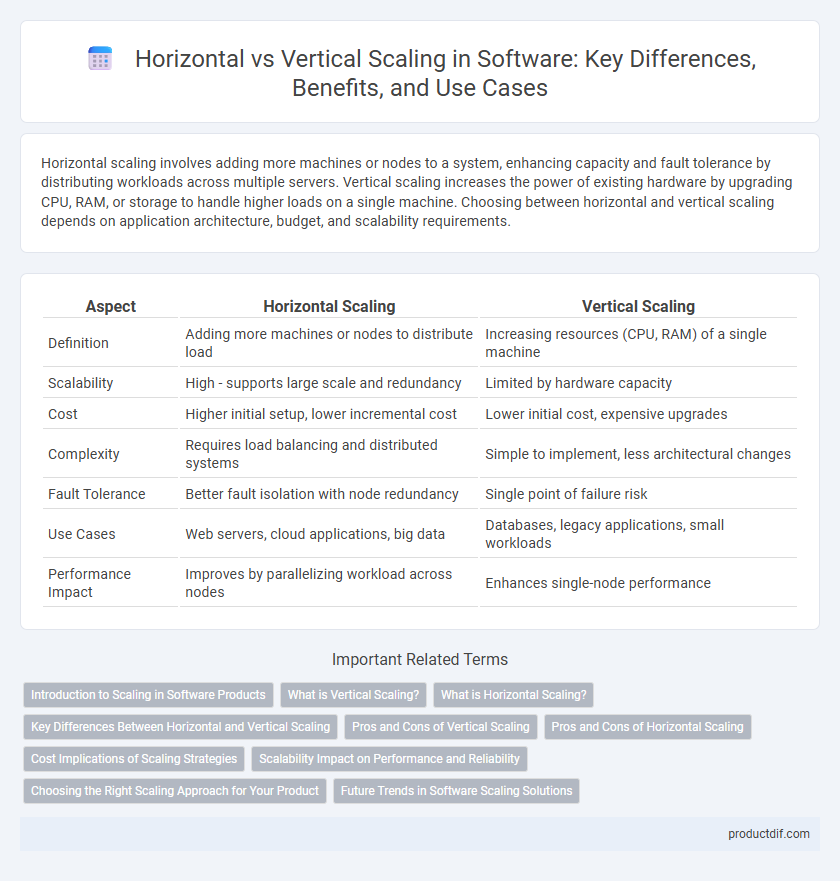Horizontal scaling involves adding more machines or nodes to a system, enhancing capacity and fault tolerance by distributing workloads across multiple servers. Vertical scaling increases the power of existing hardware by upgrading CPU, RAM, or storage to handle higher loads on a single machine. Choosing between horizontal and vertical scaling depends on application architecture, budget, and scalability requirements.
Table of Comparison
| Aspect | Horizontal Scaling | Vertical Scaling |
|---|---|---|
| Definition | Adding more machines or nodes to distribute load | Increasing resources (CPU, RAM) of a single machine |
| Scalability | High - supports large scale and redundancy | Limited by hardware capacity |
| Cost | Higher initial setup, lower incremental cost | Lower initial cost, expensive upgrades |
| Complexity | Requires load balancing and distributed systems | Simple to implement, less architectural changes |
| Fault Tolerance | Better fault isolation with node redundancy | Single point of failure risk |
| Use Cases | Web servers, cloud applications, big data | Databases, legacy applications, small workloads |
| Performance Impact | Improves by parallelizing workload across nodes | Enhances single-node performance |
Introduction to Scaling in Software Products
Horizontal scaling in software products involves adding more machines or instances to distribute workload, enhancing capacity and fault tolerance without downtime. Vertical scaling increases the power of existing hardware by upgrading CPU, RAM, or storage, allowing software to handle more intensive processes on a single server. Both strategies aim to improve performance and reliability, but horizontal scaling offers greater flexibility and resilience for cloud-native and distributed applications.
What is Vertical Scaling?
Vertical scaling, also known as scaling up, involves increasing the capacity of a single server or machine by adding more CPU, RAM, or storage resources to handle higher workloads. This approach enhances the performance of existing hardware without altering the application architecture or distributing the load across multiple servers. Vertical scaling is often limited by hardware constraints and may lead to a single point of failure if the upgraded server experiences issues.
What is Horizontal Scaling?
Horizontal scaling, also known as scaling out, involves adding more servers or nodes to a system to distribute workloads and increase capacity. This approach enhances system availability and fault tolerance by enabling load balancing across multiple machines. It is commonly used in cloud environments and distributed systems to efficiently handle growing traffic and data demands.
Key Differences Between Horizontal and Vertical Scaling
Horizontal scaling involves adding more servers or machines to distribute workloads, enhancing system capacity and fault tolerance, while vertical scaling upgrades existing hardware by increasing CPU, RAM, or storage to improve performance on a single server. Key differences include cost efficiency, where horizontal scaling offers better long-term scalability through resource distribution, versus vertical scaling's simpler implementation but limited by hardware maximums. Horizontal scaling supports high availability and redundancy, critical for cloud-native and distributed applications, whereas vertical scaling often suits monolithic systems with constraints on scaling beyond a single node.
Pros and Cons of Vertical Scaling
Vertical scaling, also known as scaling up, enhances a single server's capacity by adding more CPU, RAM, or storage, enabling improved performance without modifying the application architecture. It offers quick implementation and maintains simplicity in management but is limited by the maximum hardware capacity and can lead to costly upgrades. Vertical scaling may also introduce downtime during hardware enhancements, decreasing overall system availability compared to horizontal scaling.
Pros and Cons of Horizontal Scaling
Horizontal scaling improves system reliability and fault tolerance by distributing workloads across multiple servers, allowing seamless handling of traffic spikes and failures without downtime. It offers better flexibility and cost-efficiency, as additional resources can be added incrementally using commodity hardware compared to expensive upgrades in vertical scaling. However, horizontal scaling introduces complexity in data consistency, network latency, and requires sophisticated load balancing and distributed system management.
Cost Implications of Scaling Strategies
Horizontal scaling involves adding more servers to distribute workloads, often resulting in higher upfront hardware and operational costs but providing better fault tolerance and flexibility. Vertical scaling, or upgrading existing hardware, can be more cost-effective initially but may lead to expensive upgrades and potential downtime as limits of single machines are reached. Cost implications depend on workload characteristics, with horizontal scaling typically favored for cloud-native applications due to its scalability and resilience.
Scalability Impact on Performance and Reliability
Horizontal scaling enhances software performance and reliability by distributing workloads across multiple servers, reducing single points of failure and enabling better fault tolerance. Vertical scaling improves performance by adding more resources such as CPU, RAM, or storage to a single server but risks downtime during upgrades and has hardware limitations. Implementing horizontal scaling often leads to superior scalability, as it allows applications to handle increased demand with minimal disruption and higher availability.
Choosing the Right Scaling Approach for Your Product
Choosing the right scaling approach for your software product depends on workload characteristics and growth patterns. Horizontal scaling enhances system capacity by adding more machines, ideal for distributed applications and high availability requirements. Vertical scaling improves performance by increasing resources on a single server, suitable for applications with limited scaling complexity or legacy system constraints.
Future Trends in Software Scaling Solutions
Future trends in software scaling solutions emphasize hybrid approaches combining horizontal and vertical scaling to optimize performance and cost efficiency. Advances in container orchestration technologies like Kubernetes enable dynamic resource allocation across distributed systems, enhancing scalability and fault tolerance. Predictive analytics and AI-driven automation are increasingly integrated to proactively manage scaling based on real-time workload patterns and system health metrics.
Horizontal Scaling vs Vertical Scaling Infographic

 productdif.com
productdif.com